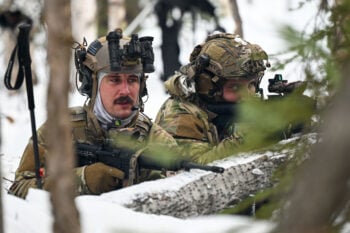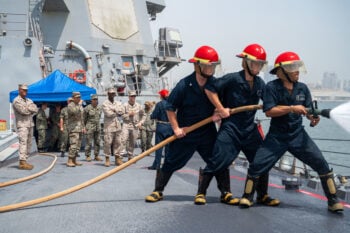
The Arleigh Burke-class guided-missile destroyer USS Carney (DDG 64) defeats a combination of Houthi missiles and unmanned aerial vehicles in the Red Sea, Oct. 19. (U.S. Navy photo by Mass Communication Specialist 2nd Class Aaron Lau)
DUBAI — The American guided missile destroyer USS Mason on Wednesday shot down a drone that a US defense official reportedly said had been launched from territory in Yemen held by the armed Houthi group.
It was only the latest incident in a string of them in which US Navy vessels have swatted unmanned aerial vehicles (UAVs) or missiles believed to have been launched by the Houthis since Hamas’s Oct. 7 attack on Israel. The Pentagon has been at pains to say in some previous cases that commercial vessels were the target and it’s unclear if anyone’s actually trying to hit American military ships.
Still, “any entity engaging in reckless and malign behavior is a threat to maritime security and the free flow of commerce,” Cmd. Richard Chernitzer, U.S. 5th Fleet Spokesman, told Breaking Defense.
RELATED: 55 days of war: The Israel-Gaza conflict by the numbers
Wednesday’s shootdown especially must’ve been an eerie echo for the Mason: Seven years ago it dodged a missile attack that also had been launched from Houthi-controlled territory.
The symmetry wouldn’t be lost on Middle East analyst David Des Roches, who said that while the US and its partners are currently grasping for a response to the Red Sea threats, it’s been a problem for years.
“The Houthi disruptive capability in the [Bab el-Mandab Strait] and Red Sea is not a new phenomenon,” said Des Roches, associate professor at the Near East and South Asia Center for Strategic Studies at National Defense University in Washington. The Bab el-Mandeb Strait connects the Red Sea with the Indian Ocean off the Yemeni coast.
Prior to Wednesday’s shootdown, on Dec. 3 three merchant ships were hit by missiles fired by the Yemeni Houthi militiamen, an attack later reportedly claimed by a Houthi spokersperson. On the same day the USS Carney shot down three drones launched by the Houthis and posed a threat to the warship, according to a statement by the U.S. Central Command.
RELATED: In wake of Hamas attack, Israel may have to change intel, tech strategy
A week before that the USS Mason foiled the hijacking of a tanker by Houthi militiamen that were later chased and apprehended by the U.S. destroyer. Shortly after, the Houthis fired two ballistic missiles in the area of the Mason, but both fell away from the destroyer.
Perhaps the Houthi’s most dramatic act came in mid-November, when the group seized the Galaxy Leader cargo ship south of the Red Sea in a helicopter-borne raid that it recorded and posted online.
The Houthi militia is a Yemeni Islamist sectarian faction that with the help of Tehran evolved from a rebel group into a formidable well-equipped force armed with Iranian-made drones, ballistic missiles, and cruise missiles. The Houthis have fought a seven-year war against a Saudi-led Arab coalition, and today control the northern part of Yemen, including the Red Sea port city of Hudaydah that is close to Bab Al-Mandeb Strait.
Des Roches told Breaking Defense the US may have presumed the Houthi threat to the Red Sea pre-Oct. 7 to have dissipated. After the incident in 2016, the US responded by firing Tomahawk missiles at a Houthi radar site.
But now the US is struggling to find an answer. Chernitzer told Breaking Defense, “While I won’t go into specifics or discuss future operational plans, what I can tell you is we’re focused on ensuring maritime security and stability.”
Earlier this week White House National Security Advisor Jake Sullivan told reporters the US was in talks with “other countries about a maritime task force of sorts involving the ships from partner nations alongside the United States in ensuring safe passage… of ships in the Red Sea.”
There is already a Combined Multinational Force, currently headed by the U.S. and known as Task Force-153, that is in charge of maritime security in the Red Sea, Bab el-Mandab Strait and Gulf of Aden area, and is based at the 5th Fleet HQ in Manama, Bahrain.
It is not yet clear whether the proposed joint task force will be a new one with a different structure or will be an expansion of the Task Force-153 that is made up of 34 nations.
Des Roches told Breaking Defense such an international effort seemed likely, but he also suggested that the international community should consider punitive actions against Iran. “Excluding Iran from the global economy until it directs its proxies to facilitate rather than impede global trade would be the best way forward,” he added.
Iran has denied involvement in any of the attacks – much as they have Hamas’s Oct. 7 attack on Israel – but the White House has emphasized Tehran’s historic connection to armed groups in the region.
“We are talking about the Houthis here. They’re the ones with their finger on the trigger. But that gun — the weapons here are being supplied by Iran. And Iran, we believe, is the ultimate party responsible for this,” Sullivan said on Dec. 4. (Today the US State Department announced it was sanctioning 13 “individuals and entities” who allegedly funded the Houthis through the selling of Iranian commodities.)
Ken Katzman, senior advisor at the Soufan Group, agreed.
“The Houthis are part of Iran’s axis of resistance, and all of the weaponry the Houthis have been using to target Israel and US naval vessels — land attack cruise missiles and armed drones — are provided by Iran. Therefore, Iran can be considered responsible for the Red Sea attacks,” he said.
Katzman predicted that the US military would strike Houthi facilities if a US ship is hit or a US military person is killed,” but for now the US appears to be trying to contain the situation.
“The U.S. is hesitant to strike the Houthis now because there is still an informal Yemen ceasefire, and the U.S. does not want the Yemen peace talks to end,” he said.
Also, Saudi Arabia reported urged the US to be restrained its response in order to avoid a negative impact the retaliation could have on Riyadh’s peace talks with the Yemeni militia.
But, Katzman said, mounting pressure on President Biden might lead to listing “the Houthis as a foreign terrorist organization” – an idea already backed by some US lawmakers.
TAI exec claims 20 Turkish KAAN fighters to be delivered in 2028
Temel Kotil, TAI’s general manager, claimed that the domestically-produced Turkish jet will outperform the F-35 Joint Strike Fighter.


























